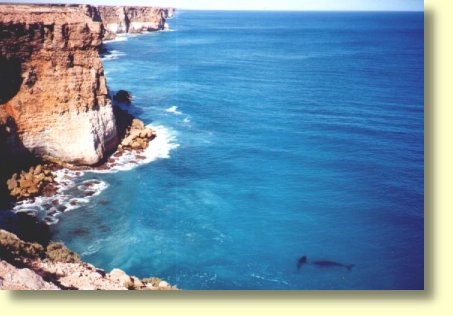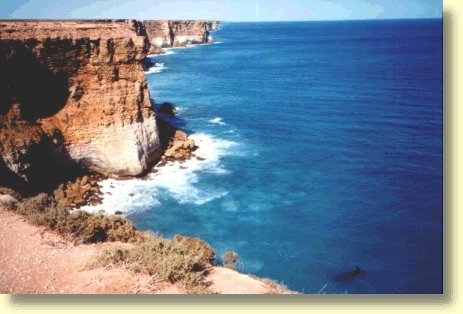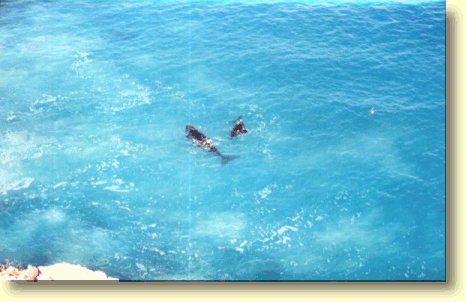|

Eubalena Australis
Some Weighty Matters
The Southern Right Whale
is a truly gargantuan creature of the seas. Frequently female Southern
Right Whales weigh in at 85 tonnes when mature. Adult males are relative
light weights at 55 tonnes or so. Typically adult female Right Whales
grow to 17.5 metres in length - with males growing perhaps 2 metres
less than females. In common with other mammals, including land based
ones such as ourselves, Southern Right Whales possess lungs, breathe
air, are warm blooded creatures, and even possess remnants of body
hair.
There's Nothing Quite Like Mother's Milk
Like other mammal species,
the female Southern Right Whale is also endowed with milk glands for
suckling their young whale calves. At birth Right Whale calves are
delivered tail first, weigh about 1 tonne and are 5.5 metres in length.
During the 3 to 4 months after birth young whale calves grow to 7
or 8 metres in length and gain on average 50 to 60 kilograms in weight
every day. These are stunning figures indeed, and by the time the
young whale calves depart for their summer Sub-Antarctic feeding grounds
they typically weigh between 6 and 8 tonnes. Southern Right Whale
milk contains upto 40% fat and this no doubt contributes to rapid
growth rates of young whales. Rapid growth rates of 50 to 60 kilograms
per day are all the more remarkable however, when you consider that
Right Whale mothers fast for the 4 to 6 months they are resident in
their breeding and nursery grounds. At The Head of Bight this is between
May and October of each year - during the Southern Hemisphere's winter
and early spring. This extended period without access to its usual
food sources of copepods and plankton is no doubt assisted by the
fact that Right Whale Blubber can be upto 40 centimetres in depth.
Clearly nursing and raising Southern Right Whale calves involves a
very high expenditure of energy. It therefore seems a likely evolutionary
imperative for female Right Whales to possess a much greater body
mass than their male counterparts. Not surprisingly female Southern
Right Whales tend to breed only every three years or so, generally
wintering in their Sub-Antarctic feeding grounds during the off breeding
cycle.

Southern Right Whale mother
and calf feeding
What Is A Baleen Whale?
Scientists classify Southern
Right Whales as belonging to the Baleen family of Whales - otherwise
known as the Mysticete sub-order of Cetacea. Members of the Baleen
family of whales possess no teeth whatsovever. Instead, nature has
endowed Right Whales and allied species with what are known as Baleen
Plates. These Baleen plates are structures that are found in the mouth
and are used as a means to filter food sources such as copepods from
sea water. The Southern Right Whale's Baleen consists of a series
of 230 pairs of elongated triangular plates suspended from each side
of the whale's upper jaw. These triangular plates have been measured
at over 2.5 metres long and are composed of a material called chitin
- a material which is very similar to human finger nails. Within the
Southern Right Whale's mouth the internal surfaces of these baleen
plates form a frayed and dense sieve like matting through which the
Right Whale filters its prey.

Basking whales
Right Whales Are Skim Feeders
Southern Right Whales are
considered "Skim Feeders" - a term which refers to the fact that this
whale searches for its food by swimming through clouds of teeming
plankton located at or very near to the ocean surface. When feeding
Southern Right Whales swim with their mouths agape thereby allowing
water to circulate through the Baleen structure which acts to trap
small copepods and a variety of phytoplankton and zooplankton species.
With its muscular tongue the Southern Right Whale swishes through
the baleen and flicks trapped prey to the back of its mouth where
it is immediately swallowed - usually one kilogram at a time.
Over the course of a day an
adult Southern Right Whale can consume upto a tonne or more of protein
rich food sources. Jenny Craig Weight Loss Centres eat your heart
out!
Today the world's Southern
Right Whale population numbers 4000 of which perhaps 600 to 800 regularly
winter along the Southern Australian coastline. At the Head of The
Great Australian Bight upto 100 Southern Right Whales converge each
year to breed, give birth and nurture young whale calves. Breeding
numbers appear to peak at 3 year intervals and are closely related
to the breeding cycles of sexually mature females.
Scientists have been observing
the movement of Southern Right Whales along the Southern Australia
coastline for many years. Results of these migration studies suggest
Southern Right Whales tend to return to the same breeding grounds
over the course of many years, and in many cases perhaps even throughout
their entire lives.
Along the Southern Australian
coastline other well documented breeding grounds and whale nurseries
include the Warrnambool coastline of Victoria, and to a lesser extent
the waters located between Albany and Hopetown in Western Australia.
Very occasionally Southern Right Whales have been observed to move
between the Head of Bight and Western Australian Breeding grounds.
Slightly more frequently movements have been observed between the
Head of Bight and Warrnambool breeding grounds - a distance of over
1000 kilometres!
To date there have been no
recorded movements between Western Australian nursery grounds and
those located in South Eastern Australia in places such as Warrnambool.
High Wave Energy Coastlines
Southern Right Whales appear
to exhibit a definite preference for breeding and nursery grounds
that are exposed to strong southerly high energy swells. Both the
Head of Bight and Warrnambool sites experience high energy waves in
an environment where steep cliffs and deep waters are adjacent to
nearby whale calving grounds.
An advantage of frequenting
such high energy coastlines is that these habitats possess high levels
of naturally occurring background sound - a feature which characteristically
makes it difficult for acoustically sensitive predators such as Killer
Whales to detect the presence of vulnerable Southern Right Whales.
Nearby deep waters also appear
to play a role in developing swimming skills and the stamina necessary
for young whales that will soon undergo an oceanic voyage to their
Sub-Antarctic feeding grounds. A distance of perhaps 4 to 5000 kilometres
to the south of the Australian continent.

The Bunda Cliffs are a high
energy coastline
A Politically Correct View of Whales
Today the Southern Right Whale
continues to remain an endangered species despite receiving international
protection from commercial whalers since 1935. From a peak population
of 100,000 Southern Right Whales in the early 1800s, numbers have
now stabilised, and may even be marginally increasing from a low base
of 4000 creatures. Between 1820 and 1850 some 26,000 whales were mercilessly
slaughtered in Australian and New Zealand waters. And all this mayhem
was in order to satisfy man's demand for lamp oil, brushes, candles,
and perhaps most insidiously of all, to satisfy the demands of fashion
for women's corsets.
Whilst the plight of the
magnificent Southern Right Whale may have stabilised, many other whale
species are even more acutely threatened. Surprisingly there are nations
in the world that still sponsor the commercial exploitation of whales
as a food source. Today the nations of Norway, Iceland and the Faroe
Islands continue to hunt whales.
Perhaps the worst culprit
of all is Japan which spuriously maintains its need to hunt Minke
Whales and other species in order to conduct scientific studies. In
fact nothing could be further from the truth and whale meat continues
to be sold as a luxury item and delicacy in expensive Tokyo restaurants.
Nullarbor Net asks you to
actively oppose such commercial whaling operations by lobbying any
government that continues to condone the killing of whales.
For those of you who are not
sure where to start why not visit the whale page of Greenpeace's internet
site. The address of this site is www.greenpeace.org and here you
will see Greenpeace is currently running an Email campaign gainst
Japanese and Norwegian Whalers. Why not Email the Prime Minister of
Norway? Before the last American presidential election Greenpeace
was also active in lobbying Bill Clinton with view to ending all commercial
whaling. At Nullarbor Net our message is quite simple - Whales definitely
thrive best when left to their own devices.

Whales in the water, not
on dinner plates!
Weird Whale Facts
- The male Southern Right Whale possesses the largest pair of
testes in the animal kingdom. A pair of Right Whale testes can
weigh upto a tonne.
- Unlike fish, sharks and many other
whales, the Southern Right Whale possesses no dorsal fin whatsoever.The
Southern Right Whale is a smooth backed whale.
- The male Southern Right Whale penis
can be up to 2.5 metres long.
- Southern Right Whales have a "vee
shaped" blowhole with spray exiting the vent in 2 streams at an
angle of 45 degrees from the perpendicular.
- Female Right Whales are sexually promiscuous.
This is probably related to the fact that females are only able
to breed once every 3 years whereas males are able to breed every
year. From the male Southern Right Whale's perspective there is
always a shortage of breeding females.
- When migrating between their feeding
and breeding grounds the normal "cruising speed" of a Right Whale
is about 4 kilometres per hour.
- The Southern Right Whale's nearest
relative is the Northern Right Whale. As the name would suggest
the Northern Right Whale lives in the Northern Hemisphere. The
Northern Right Whale is extremely endangered with only a few hundred
remaining alive. During the last Ice Age ancestral populations
of Right Whales moved between the Northern and Southern Hemispheres.
- Today Northern Right Whales and Southern
Right Whales are permanently separated by an 8500 kilometre band
of warm tropical water. Scientists now classify these 2 populations
of Right Whales as being separate species.
- And finally, Southern Right Whales
are not good advertisements for Jenny Craig Weight Loss Centres
- and that's a fact!
|








